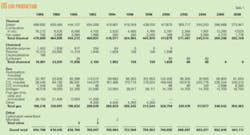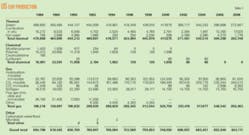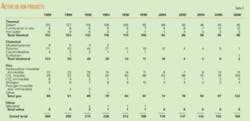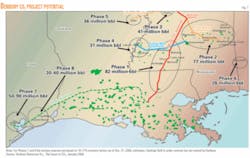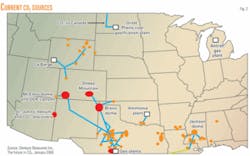Oil & Gas Journal’s exclusive biennial enhanced oil recovery (EOR) survey, p. 47 shows that the number of EOR projects in the US has increased compared with the last survey taken 2 years ago. Although the current survey lists more projects, total production from all US EOR projects is less than in the last survey.
Production decline in California steam injection projects mostly accounts for the lower production, while new carbon dioxide floods mostly account for the increase in projects.
Outside of the US, the number of projects continues to increase, although operators for some of these projects did not update information listed in the previous survey (OGJ, Apr. 17, 2006, p. 37).
Survey description
OGJ published its first EOR survey in May 3, 1971, and the survey has been a biennial OGJ feature since 1974.
Tables A through E (pp. 47-59) list the projects in the 2008 EOR survey.
Projects listed are those that involve injecting fluids, other than water or methane, into a reservoir to improve or enhance oil recovery. Operators use the injectants during the initial production stage, after the primary depletion stage, or after the secondary production stage, which also is known as tertiary recovery.
The most common injectants include:
- Steam in heavy oil fields at shallower depths.
- Air for in situ combustion projects.
- Carbon dioxide in lighter oil fields.
- Hydrocarbon miscible gas in lighter oil fields.
- Chemicals and polymer in lighter oil fields.
Acid gas, a concentrated stream of hydrogen sulfide and carbon dioxide, is a new type of injectant seeing applications in EOR. Apache Canada Ltd. has a pilot in the Zama field in northwestern Alberta that produces about 1,000 bo/d.
Chevron Corp. also injects sour gas as part of its second-generation project in the Tengiz field in Kazakhstan. A Chevron Mar. 13, 2008, presentation to analysts said that this expansion has increased production by 250,000 bo/d.
Petroleum Development Oman also has under development the $1 billion Harweel sour-gas injection project in southern Oman. PDO expects production for Phase 2AB of the project to produce about 60,000 bo/d by 2010, with a potential in the next decade of production increasing to 100,000 bo/d from the 10 fields in the cluster (OGJ, Nov. 5, 2007, p. 52).
US projects
OGJ’s survey shows EOR contributing 643,000 b/d to US oil production (Tables 1 and 2), a 9,700-bo/d decrease from the 2006 survey. The production numbers represent the estimated production at the beginning of the year.
The survey includes 184 active projects, an increase of 32 compared with the 2006 survey.
Oil production decline in the mature thermal heavy-oil projects, mostly in California, is the main explanation for production decreasing. Production from US projects using thermal methods peaked in 1986 at 480,000 bo/d and has declined to the current 292,000 bo/d, or 12,000 bo/d less than shown in the 2006 survey.
Chevron Corp.’s operated Kern River field remains the largest single EOR project in the US, producing about 83,000 b/d, based on California Conservation Department statistics. Updated EOR statistics from Chevron were not available at press time.
Aera Energy LLC, a venture of ExxonMobil Corp. and Shell Inc., produces 95,000 bo/d from 17 projects, but this is a decrease from the 107,000 bo/d listed in the 2006 survey.
Oil production from in situ combustion has increased to 17,000 bo/d or 4,000 bo/d more than in the last survey. Encore Acquisition Co. has three projects while Continental Resources Inc. has 12 in fields in North and South Dakota as well as in Montana.
The combustion project with the most production is Continental Resources’ Ceder Hill North Unit in Bowman County, ND. The company says the unit produces 11,500 bo/d or an increase of 3,400 bo/d from the last survey.
Thermal projects typically have long lives. For instance, the fire flood in Louisiana’s Bellevue field started in 1970 and the field still produces 280 bo/d, while steam injection started in California’s Belridge field, now operated by Aera, in 1961; the field currently produces 33,000 bo/d.
Steam injection projects outside of California also include a TXCO pilot in the Maverick basin of South Texas and MegaWest Energy’s planned pilot in Vernon County, Mo.
In the US, the number of CO2 miscible injection projects for enhancing oil recovery has increased (Table 1). The survey lists 100 ongoing projects compared with the 79 in the 2006 survey. Enhanced oil recovered from these projects also has increased to 240,000 b/d from the 235,000 b/d shown in the previous survey.
Units of Occidental Petroleum Corp. continue to add CO2 projects. Oxy now operates 28 projects compared with 27 listed in the 2006 survey.
Denbury Resources Inc. also has added CO2 floods. It now has 13 active floods compared with 7 listed in the previous survey. All of its CO2 floods are in Mississippi except for one in Louisiana. Fig. 1 shows Denbury’s existing and planned fields.
Oxy’s Wasson Denver Unit is the field with the most CO2 EOR production, producing 26,850 bo/d. CO2 injection in the field started in 1983.
Most US hydrocarbon miscible projects are on the North Slope of Alaska with the largest in the Prudhoe Bay and Kuparuk River fields.
The survey does not include any US EOR projects that involve injecting surfactants, polymers, or other chemicals. These projects tend to be smaller and with shorter lives, and operators chose not to respond to the survey.
One recent announcement on a chemical flood is Rex Energy’s plan for starting two alkali-surfactant-polymer (ASP) pilots in an old oil field in the Illinois basin in second-quarter 2008. (OGJ, Feb. 11, 2008, p. 39).
The pilots will be on 1-acre spacing in Lawrence field, near Bridgeport, Ill. Lawrence field, discovered in 1906, still produces about 1,800 bo/d from 1,000 wells and Rex Energy says initial oil in place in the field, the largest in the Illinois basin, was an estimated 1 billion bbl of which about 400 million bbl has been produced
Another chemical flood is Cano Petroleum Inc. alkaline-surfactant-polymer pilot consisting of four wells on 2.5 acres in the Nowata field. ASP injection started toward the end of 2007 and Cano expects incremental oil production in 2008.
CO2 availability
Availability of CO2 limits industry’s ability to expand CO2 EOR flooding in the US (Fig. 2). Charles Fox, vice-president of Kinder Morgan Carbon Dioxide Co., told OGJ that the company had completed its DOE canyon gas plant in southwestern Colorado in early 2008, thereby adding 107 MMcfd of CO2 availability to the Permian basin of West Texas and New Mexico. He added that expansion in McElmo dome, also in Colorado, by mid-2008 will add another 200 MMcfd of CO2 production capacity. The addition CO2 form McElmo dome and DOE canyon has been already sold to existing projects and to the North Ward Estes EOR project, which is the anchor field for deliveries from DOE canyon, Fox said.
In 2007, Fox noted that the average amount of CO2 deliveries to the Permian basin was 1.371 bcf/day, broken down as 966 MMcfd from McElmo dome, 290 MMcfd from Bravo dome, 40 MMcfd from Sheep Mountain, and 75 MMcfd from Val Verde gas plants. These deliveries were slightly less than the 1.388 bcf/day delivered in 2006. Fox explains that the lower deliveries were due to an imbalance in demand and supply during summer 2007. He expects CO2 deliveries to the Permian basin during 2008 will set a record.
Enhanced Oil Resources Inc. recently announce a memorandum of understanding (MOU) for developing a pipeline with SunCoast Energy Corp. to carry CO2 350 miles from its St. Johns, Ariz., helium and CO2 field to the Permian basin. The company’s initial plans are to transport 350 MMcfd of CO2 into the Permian basin. The pipeline design capacity will be 500 MMcfd.
EOR Inc. has reserved the right to the first 175 MMcfd of capacity for its own oil field in the basin and for some other targeted fields.
If both company’s meet their obligations, EOR Inc. expects the pipeline to be built by late 2010.
Denbury has plans to increase its CO2 pipeline, with one possible line transporting CO2 into East Texas. The company also has signed CO2 purchase contracts with three planned chemical plants. In a January presentation, Denbury said, contingent on the plants being built, it expects to obtain:
- 190-225 MMcfd from the Faustina petroleum coke gasification plant, Donaldsonville, La., starting in 2010.
- 190-225 MMcfd from the USTransCarbon gasification plant, Beaumont, Tex., starting in 2011.
- 350-400 MMcfd from the Rentech gasification plant, Natchez, Miss., starting in 2011-12.
In Wyoming, Anadarko Corp. has plans to extend to the Linch-Sussex area its 125-mile pipeline that currently transports CO2 to the Salt Creek and Monell fields. The La Barge gas plant is the source for this CO2.
Canadian EOR
Expansion of in situ production through steam-assisted gravity drainage (SAGD) and cyclic-steam projects continues at a rapid pace. Responses to the survey from some companies along with information from an Alberta Employment, Immigration, and Industry, December 2007 report indicate that the following projects were producing:
- ConocoPhillips Canada began producing from Phase 1 of its Surmont SAGD project in 2007 with a designed capacity of producing 25,000 bo/d.
- Devon Energy Corp. completed construction of its Jackfish Phase 1 SAGD project with first steaming starting in the third quarter of 2007.
- Connacher Oil & Gas Corp. completed construction at Pod 1 of its Great Divide SAGD Project. Production started in the fourth quarter of 2007 and the company expects to reach 10,000 bo/d in late 2008.
- Petro-Canada production averaged 22,000 bo/d during third quarter 2007 at its MacKay River in situ project.
- EnCana Energy Corp.’s in situ SAGD Christina Lake project produces about 6,000 bo/d and its SAGD Foster Creek project produced 52,000 bo/d.
- Japan Canada Oil Sands (JACOS) SAGD Hangingstone pilot produces an average 8,000-8,500 bo/d.
- Total E&P Canada Ltd. started SAGD production from its Joslyn project in November 2006 and targets 10,000 b/d for 2008.
- Shell Canada Energy Ltd. started production from its Orion SAGD project at yearend 2007. Designed capacity is 10,000 bo/d.
- Canadian Natural Resources Ltd. is producing 70,000 b/d from its Primrose in situ cyclic steam project.
- Husky Energy started producing at its Tucker SAGD project, designed for 30,000 bo/d.
- Shell Canada Energy Ltd.’s Peace River projects produced 18,000 bo/d at yearend 2007.
- Suncor Energy Inc.’s Firebag SAGD was producing at about 29,000 bo/d.
- The largest steam project remains Imperial Oil Ltd’s. Cold Lake, averaging about 154,000 bo/d in 2007.
Other countries
Chevron Corp.’s operated Duri field on Sumatra Island in Indonesia remains the largest single EOR project in the world, producing about 190,000 bo/d.
In 2007, Chevron announced the start of surfactant-polymer pilot in Minas field, the largest field in Indonesia, with about 4 billion bbl of oil initially in place. The company expects to start chemical injection in early 2011 and expects results in 2012.
Chevron also has under construction the North Duri steamflood that will start producing in 2008 and is expected to attain 70,000 bo/d of production.
Another steamflood Chevron has under construction is in the Neutral Zone between Suadi Arabia and Kuwait. Production started in 2007 and Chevron expects production to reach 10,000 bo/d in 2008.
Other countries with active EOR projects include China and Venezuela, although the operators did not update the statistics for these projects.
Petroleos Mexicanos had good success in increasing oil production with nitrogen injection in the offshore Cantarell field , where oil production increased to more than 2 million b/d in 2004 from the 1 million b/d in 1996. Currently Cantarell produces about 1.8 million b/d.
Pemex also has started nitrogen injection in the Ku-Maloob-Zapp, and Jujo Tecominoacan fields.
Bankers Petroleum Ltd. began a steam injection pilot in the Patos Marinza in Albania. The Company expects to drill eight new wells in its thermal steam project in the fourth quarter of 2008.
Petroleum Development Oman besides its Harweel sour-gas injection project, in 2007 started injected steam in the Amal West field pilot (OGJ, Nov. 5, 2007, pp. 56-65). In 2008, it has plans to start steam injection pilots in Amal East and Thayfut fields in 2008. Other PDO EOR projects under construction are steam projects in Qarn Alam and Fahud fields, as wells as a polymer flood in Marmul field. It expects Qarn Alam to come on stream in 2010 and produce about 30,000 bo/d and to start in 2008 steam injection in Fahud and polymer injection in Marmul. In Oman, Occidental is also developing the Mukhalza steam injection project.
About this report...
Every 2 years, the Oil & Gas Journal surveys worldwide projects that use various injection technologies to enhance oil recovery. Tables showing the projects surveyed start on p. 47, while the following pages describe events and trends affecting EOR activity levels.
